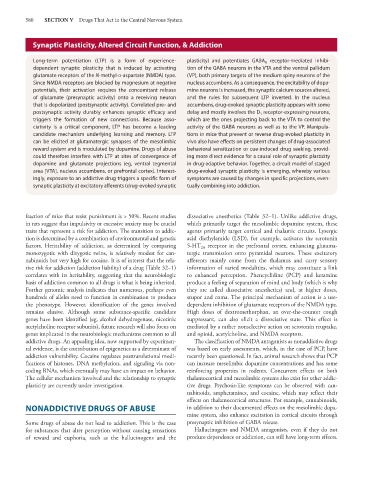Page 594 - Basic _ Clinical Pharmacology ( PDFDrive )
P. 594
580 SECTION V Drugs That Act in the Central Nervous System
Synaptic Plasticity, Altered Circuit Function, & Addiction
Long-term potentiation (LTP) is a form of experience- plasticity) and potentiates GABA A receptor-mediated inhibi-
dependent synaptic plasticity that is induced by activating tion of the GABA neurons in the VTA and the ventral pallidum
glutamate receptors of the N-methyl-d-aspartate (NMDA) type. (VP), both primary targets of the medium spiny neurons of the
Since NMDA receptors are blocked by magnesium at negative nucleus accumbens. As a consequence, the excitability of dopa-
potentials, their activation requires the concomitant release mine neurons is increased, the synaptic calcium sources altered,
of glutamate (presynaptic activity) onto a receiving neuron and the rules for subsequent LTP inverted. In the nucleus
that is depolarized (postsynaptic activity). Correlated pre- and accumbens, drug-evoked synaptic plasticity appears with some
postsynaptic activity durably enhances synaptic efficacy and delay and mostly involves the D 1 receptor-expressing neurons,
triggers the formation of new connections. Because asso- which are the ones projecting back to the VTA to control the
ciativity is a critical component, LTP has become a leading activity of the GABA neurons as well as to the VP. Manipula-
candidate mechanism underlying learning and memory. LTP tions in mice that prevent or reverse drug-evoked plasticity in
can be elicited at glutamatergic synapses of the mesolimbic vivo also have effects on persistent changes of drug-associated
reward system and is modulated by dopamine. Drugs of abuse behavioral sensitization or cue-induced drug seeking, provid-
could therefore interfere with LTP at sites of convergence of ing more direct evidence for a causal role of synaptic plasticity
dopamine and glutamate projections (eg, ventral tegmental in drug-adaptive behavior. Together, a circuit model of staged
area [VTA], nucleus accumbens, or prefrontal cortex). Interest- drug-evoked synaptic plasticity is emerging, whereby various
ingly, exposure to an addictive drug triggers a specific form of symptoms are caused by changes in specific projections, even-
synaptic plasticity at excitatory afferents (drug-evoked synaptic tually combining into addiction.
fraction of mice that resist punishment is > 50%. Recent studies dissociative anesthetics (Table 32–1). Unlike addictive drugs,
in rats suggest that impulsivity or excessive anxiety may be crucial which primarily target the mesolimbic dopamine system, these
traits that represent a risk for addiction. The transition to addic- agents primarily target cortical and thalamic circuits. Lysergic
tion is determined by a combination of environmental and genetic acid diethylamide (LSD), for example, activates the serotonin
factors. Heritability of addiction, as determined by comparing 5-HT receptor in the prefrontal cortex, enhancing glutama-
2A
monozygotic with dizygotic twins, is relatively modest for can- tergic transmission onto pyramidal neurons. These excitatory
nabinoids but very high for cocaine. It is of interest that the rela- afferents mainly come from the thalamus and carry sensory
tive risk for addiction (addiction liability) of a drug (Table 32–1) information of varied modalities, which may constitute a link
correlates with its heritability, suggesting that the neurobiologic to enhanced perception. Phencyclidine (PCP) and ketamine
basis of addiction common to all drugs is what is being inherited. produce a feeling of separation of mind and body (which is why
Further genomic analysis indicates that numerous, perhaps even they are called dissociative anesthetics) and, at higher doses,
hundreds of alleles need to function in combination to produce stupor and coma. The principal mechanism of action is a use-
the phenotype. However, identification of the genes involved dependent inhibition of glutamate receptors of the NMDA type.
remains elusive. Although some substance-specific candidate High doses of dextromethorphan, an over-the-counter cough
genes have been identified (eg, alcohol dehydrogenase, nicotinic suppressant, can also elicit a dissociative state. This effect is
acetylcholine receptor subunits), future research will also focus on mediated by a rather nonselective action on serotonin reuptake,
genes implicated in the neurobiologic mechanisms common to all and opioid, acetylcholine, and NMDA receptors.
addictive drugs. An appealing idea, now supported by experimen- The classification of NMDA antagonists as nonaddictive drugs
tal evidence, is the contribution of epigenetics as a determinant of was based on early assessments, which, in the case of PCP, have
addiction vulnerability. Cocaine regulates posttranslational modi- recently been questioned. In fact, animal research shows that PCP
fications of histones, DNA methylation, and signaling via non- can increase mesolimbic dopamine concentrations and has some
coding RNAs, which eventually may have an impact on behavior. reinforcing properties in rodents. Concurrent effects on both
The cellular mechanism involved and the relationship to synaptic thalamocortical and mesolimbic systems also exist for other addic-
plasticity are currently under investigation. tive drugs. Psychosis-like symptoms can be observed with can-
nabinoids, amphetamines, and cocaine, which may reflect their
effects on thalamocortical structures. For example, cannabinoids,
NONADDICTIVE DRUGS OF ABUSE in addition to their documented effects on the mesolimbic dopa-
mine system, also enhance excitation in cortical circuits through
Some drugs of abuse do not lead to addiction. This is the case presynaptic inhibition of GABA release.
for substances that alter perception without causing sensations Hallucinogens and NMDA antagonists, even if they do not
of reward and euphoria, such as the hallucinogens and the produce dependence or addiction, can still have long-term effects.

